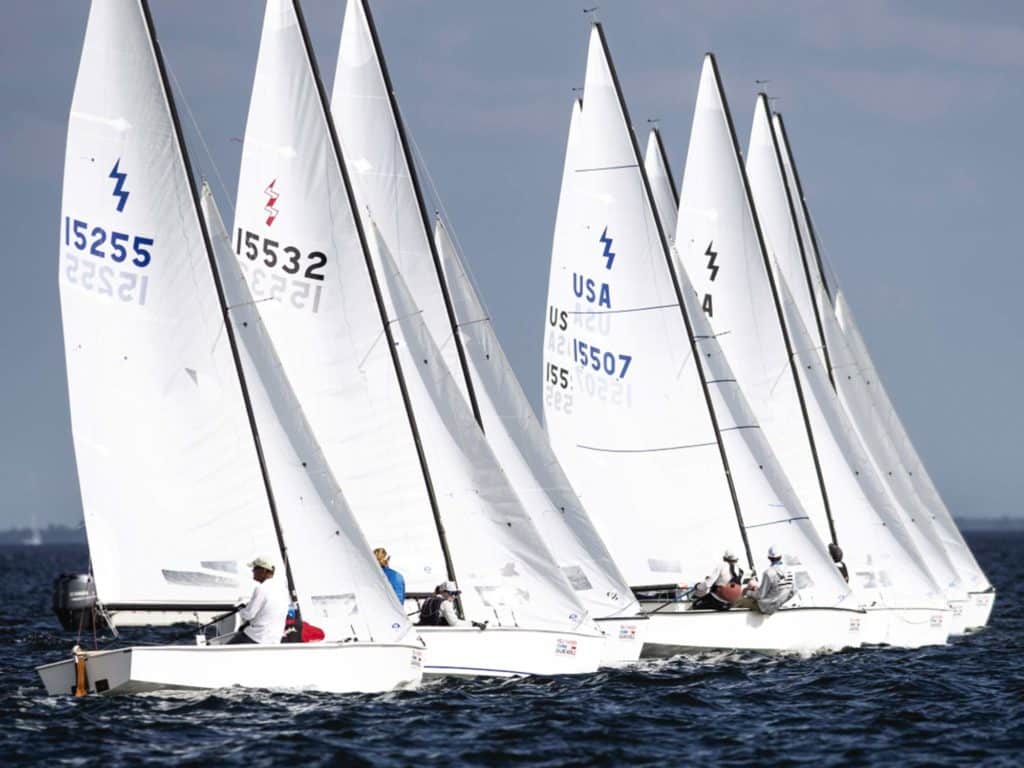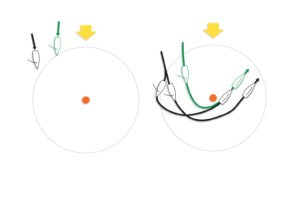
Sailing is a simple sport. It’s easy to get caught up overthinking it, but if you want to do well, just remember there’s a basic way to do everything, from starts to boat handling and straight-line boatspeed. However, getting a good start is the first step to getting good results, so let’s get to the basics of getting off the line and then take it from there.
First things first: Get out to the racecourse at least an hour early. In the half-hour or so before the start, do a number of head-to-wind checks. I do them in a timed sequence, not randomly, which is important. It could be every five minutes or every two minutes, but absolutely do your checks in the same time sequence so that what you record isn’t random. If the wind oscillates through a specific time period, you can better identify the timing of the shifts. If you do your checks at random, you could miss an oscillation. You’re looking for a pattern, so keep doing it until you recognize one. Then go off and sail upwind on both tacks. Record your headings relative to your head-to-wind readings—just write them on the deck or wherever is easiest.
The next thing I’ll do is ping the line once it’s set. One thing we see people do wrong is they ping the line going head-to-wind. You don’t start head-to-wind, so you want to ping it on your normal upwind angle; otherwise, whatever device you’re using will be inaccurate. You can do your ping on either side of the pin; it doesn’t matter. The angle should be whatever angle you’d start the boat at, and you want to be going straight for about five seconds before the ping so the GPS isn’t in wandering mode.
Next is your line sight. I won’t start without having a line sight. In fact, I will do three specific line sights: one on the line, one from two boatlengths down, and one that’s four boatlengths down from the line. Your first line sight will be on the line, your second will be one length back, and your third will be two lengths back from the middle of the line.
While you’re doing sights, run along the line, or use a handheld compass and figure out the bearing of the line. Either subtract or add 90 degrees, depending on which end you’re facing, and you’ll know what wind direction the line is even for. If the wind is right of that, then the boat is favored; if it’s left of that, then the pin is favored. It’s simple, and you can do it anywhere on the line.
Now that you’ve recorded your wind checks, have a good sense of what the wind pattern is doing, and have your line numbers, it’s time to take at least two runs at the line. You want two runs of at least a minute, on starboard tack, to get your ratio of time and distance to the line. The most commonly used starting devices display distance in meters. So, for example, let’s say you go 2 meters for every second. That means you can be 120 meters behind the line and hard on the line with no interference—that gets you to the line on time and at speed. So, do two of those runs to feel what that ratio is. Let’s say the ratio is 1-to-1 (like it usually is), and I have 30 seconds to go but I’m 40 meters from the line. This tells me I will be 10 meters late no matter what I do. That’s why it’s important to have that ratio.
It’s also important to keep in mind that you can always slow down. You can’t go faster when you’re hard on the wind. So, when I get to the actual number and still have 40 seconds to go, and there’s anyone between me and the line, I’m not going to get there on time because I don’t have a clear line.
Again, you’ll need a couple of runs to get that ratio right. And then, of course, the ratio depends hugely if you’re on a lift or a header in that moment. If it’s a header, you’ll need more time to get to the line; if it’s a lift, you’ll get to the line sooner, so it’s important to know where you are at, and that’s why it’s important know where you are in the wind pattern. You might have a 1-to-1 ratio in an even wind, but if you’re in a header, you better plan on an extra 10 seconds. If you’re in a lift, you might need to burn 10 seconds more.
The final bit of prep is with two and a half minutes to go before the start. Here, I’ll set up a couple of boatlengths over the line, near the middle, and do my last head-to-wind check. Why? Because I want clear air to do the check. This tells me where the windshift is in the cycle and where I want to start.
A good start is being able to sail for three minutes uninterrupted, in clear air, and not restricted by the boat below. If you can do that alone, you’ll be in the top percent at the weather mark, regardless of what happens after that. If you want to go right, then you need to start in a place that allows you to go right within 30 to 40 seconds after the start. I’m always willing to give up a boatlength or two to not start in the perfect place on the line if I have a reason to go to the right. Off the starting line, if it’s a header and oscillating, you want to go fast to the next shift. If you’re in a persistent shift, then you want to go high into it, not fast forward. It really is that simple.
Starting at the favored end isn’t the ticket to success—most of the time. It’s more important to be able to go the direction you want immediately. At some point after the start you will need to tack, and that should be as soon as you’re confident you can cross the boats behind you and on the other side. Don’t wait until you get to the layline. It’s OK to give up a few boats on your side to go back a little early and be able to close off half or more of the fleet. It’s a good gamble, and we don’t see that done often enough. The best people can see the big picture and a couple of moves ahead. They can see what wins the regatta rather than that race, and that’s a big distinction.
Soon after the start, you should be sailing either offense or defense. Offense means you’re not happy with where you are in the race, and you have to take some chances to improve yourself in the regatta.
Now, we all know even the best plans can go wrong in the closing minutes of the start, especially in big fleets, so it’s also important to have an exit plan so you’re not getting tacked on right of the start and bounced back and forth. Predetermine which tack you want to be on and where you want to go. So, if things go wrong, determine ahead of time whether you want to exit on port or starboard tack, and be ready to do it.
In the bottom third of the racecourse, meaning soon after the start, you should be sailing either offense or defense. Offense means you’re not happy with where you are in the race, and you have to take some chances to improve yourself in the regatta. Defense means you’re happy with where you are in the regatta, and you stay with the group you’re with. You’re doing anything you can to maintain your position rather than doing everything you can to go forward in the fleet. Just like any other sport, playing offense or defense means you have to count points—and I’m astonished by how many good sailors do not.
A word about relying on GPS devices and pings: You have to be careful because the race committee will occasionally move stuff after you’ve pinged, so these might not be accurate. This is why it’s important to use your eyesight and your line sights all the time. For example, if your ping says you have 15 meters to go and your eyes tell you differently, then you better be careful.
Also, if you have your ratio to the line and know you’re behind it, it’s better to make something happen sooner—even if that means a tack. It’s better to tack with 30 seconds to go than a minute or two after the start when you’re about to get ping-ponged. Decide at 30 seconds to go whether your approach is going to work. If not, you can either tack or put the bow down and try to sail around people who are going slow. Either way, you can’t just sit there and wait. When things are good, time is your friend; when things are bad, time is your enemy. If you don’t like what’s going on in the moment, do something about it. It really is that simple.









